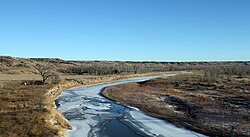Cheyenne River
| Cheyenne River Lakota: Wakpá Wašté; "Good River" | |
|---|---|
 | |
 Cheyenne River course and watershed. | |
| Etymology | Cheyenne Native American Tribe |
| Location | |
| Country | United States |
| State | Wyoming, South Dakota |
| Physical characteristics | |
| Source | Thunder Basin National Grassland |
| • location | Converse County, Wyoming |
| • coordinates | 43°25′33″N 105°03′30″W / 43.425928°N 105.058426°W |
| Mouth | Lake Oahe / Missouri River |
• location | Ziebach County / Haakon County, South Dakota |
• coordinates | 44°43′26″N 101°10′00″W / 44.723965°N 101.166749°W |
| Length | 295 mi (475 km) |
| Basin size | 24,240 sq mi (62,800 km2) |
The Cheyenne River (Template:Lang-lkt; "Good River"[1]), also written Chyone,[2] referring to the Cheyenne people who once lived there,[3] is a tributary of the Missouri River in the U.S. states of Wyoming and South Dakota. It is approximately 295 miles (475 km) long and drains an area of 24,240 square miles (62,800 km2).[4] About 60% of the drainage basin is in South Dakota and almost all of the remainder is in Wyoming.[5]
Course
Formed by the confluence of Antelope Creek and Dry Fork Creek in Wyoming, it rises in northeastern Wyoming in the Thunder Basin National Grassland in Converse County. It flows east into South Dakota, passes Edgemont, and skirts the southern end of the Black Hills, passing through Angostura Reservoir. On the east side of the Black Hills, it flows northeast, past Oral, the Buffalo Gap National Grassland and along the northwestern boundary of the Pine Ridge Indian Reservation and Badlands National Park. It is joined by Rapid Creek, passes Wasta and is joined by the Belle Fourche River in eastern Meade County, after which it flows ENE along the southern boundary of the Cheyenne River Indian Reservation. Near the town of Cherry Creek, it is joined by Cherry Creek and flows into the Missouri at Lake Oahe, approximately 32 mi (50 km) NNW of Pierre, South Dakota, with the lower 35 mi (56 km) of the river forming an arm of Lake Oahe.
The Belle Fourche River is the largest tributary of the Cheyenne. Rapid, Sulphur, Plum, Cherry, and Owl Creeks are important other tributaries of the Belle Fourche-Cheyenne. Snowmelt from the Black Hills provides the major source of river water. Because of the proximity to the Black Hills and its mining industry, the Cheyenne historically picked up large quantities of zinc, arsenic, and cyanide. Those pollutants are no longer a major threat due to water quality regulations. The Cheyenne River is still higher in dissolved mineral content than any other South Dakota major river.[5]
Cheyenne Watershed
The Cheyenne watershed is part of the Missouri River watershed and spans the Mountain West and Great Plains states of northeastern Wyoming, southwestern and south central South Dakota, as well as small areas of northwestern Nebraska, and southeastern Montana.[6] As of 2001, the Cheyenne watershed was primarily grassland (62.8%), followed by shrubland (16.3%) and forest cover (11.9%).[6] The primary population centers include Rapid City, South Dakota and Gillette, Wyoming.[6]
With a population of nearly 4.5 million in these states,[7] water use was an average of 5,254 million gallons per day in 2010.[8] This amounts to approximately 1,170 gallons per person per day. A total of 1,855 thousand acre-feet of water (more than 600 million gallons) are stored in 9 lakes and reservoirs in the Cheyenne watershed.[9]
Sedimentation is a major water quality concern for the Cheyenne watershed, potentially resulting in reduced storage capacity for reservoirs. Major water issues in the Cheyenne, reflect those of the larger Missouri River basin and stem from anticipated effects from a warming climate.[10]
Industrial use
Demand for water from agriculture for irrigation, greater threats to viable habitat for endangered species and wildlife are large concerns directly related to increasing temperatures and evapotranspiration. Water companies are also concerned about "water delivery" in response to shifting runoff periods. Similarly, power companies are concerned about climate effects on hydropower generation.[10]
As of November 2019, TC Energy was applying for permits in the state to tap the Cheyenne River to use water for the construction of Phase 4 of the Keystone pipeline, including camp construction to house transient construction workers.[11]
See also
References
- ^ Ullrich, Jan, ed. (2011). New Lakota Dictionary (2nd ed.). Bloomington, IN: Lakota Language Consortium. pp. 607, 626, 883. ISBN 978-0-9761082-9-0. LCCN 2008922508.
- ^ Marshall, Thomas Maitland, ed. (1923). The life and papers of Frederick Bates. St Louis MO: Missouri Historical Society. vol 1, p 203 - 1807 Hunting Licenses Granted July 6 Primo and Bessonett On the Chyone
- ^ Federal Writers' Project (1940). South Dakota place-names, v.3. University of South Dakota. p. 4.
- ^ "Archived copy" (PDF). Archived from the original (PDF) on 2011-07-15. Retrieved 2010-11-14.
{{cite web}}: CS1 maint: archived copy as title (link) Cheyenne River Phase I TMDL Assessment - ^ a b Hogan, Edward Patrick; Fouberg, Erin Hogan (2001). The Geography of South Dakota (Third ed.). Sioux Falls, SD: The Center for Western Studies – Augustana College. ISBN 0-931170-79-6.
- ^ a b c "USGS EDNA-Derived Watershed Characteristics". edna.usgs.gov. Retrieved 2016-10-10.
- ^ "US Census Data 2015". www.census.gov. Retrieved October 1, 2016.
- ^ "Estimated Use of Water in the United States in 2010" (PDF). pubs.usgs.gov. Retrieved October 1, 2016.
- ^ "US Bureau of Reclamation Snowpack and Reservoir Levels". Retrieved October 4, 2016.
- ^ a b "Reclamation: Managing Water in the West Chapter 6: Missouri River Basin" (PDF). www.usbr.gov. US Department of the Interior. March 2016. Retrieved October 4, 2016.
- ^ STEPHEN GROVES (2019-11-01). "South Dakota Keystone XL opponents point to N. Dakota spill". The Associated Press. Retrieved 2019-11-09.
